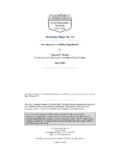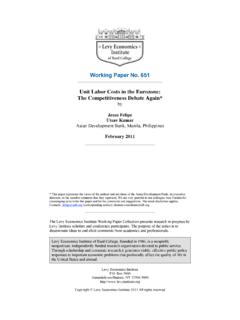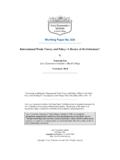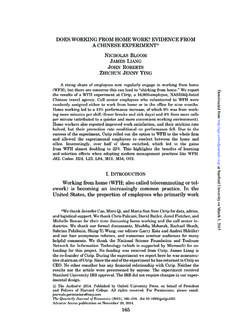Transcription of THE MACROECONOMIC EFFECTS OF STUDENT DEBT …
1 Of Bard CollegeLevy EconomicsInstituteTHEMACROECONOMIC EFFECTS OF STUDENT debt CANCELLATIONS cott Fullwiler, Stephanie Kelton, Catherine Ruetschlin, and Marshall SteinbaumFebruary 20182 STUDENT debt Cancellation Report 2018 Levy Economics Institute of Bard College 3 THE MACROECONOMIC EFFECTS OF STUDENT debt CANCELLATIONS cott Fullwiler, Stephanie Kelton, Catherine Ruetschlin, and Marshall Steinbaum4 STUDENT debt Cancellation Report 2018 Table of ContentsEXECUTIVE SUMMARY 6 INTRODUCTION 7 SECTION 1.
2 THE ECONOMIC OPPORTUNITY OF STUDENT debt CANCELLATION 9 Social Investment in Higher Education 9 The current state of STUDENT debt 10 The social costs of STUDENT debt 12 The Distributional Consequences of STUDENT debt , STUDENT debt Cancellation, and debt -Free College 13 The distribution of STUDENT debt and debt burden in the cross section 14 The evolution of the distribution of STUDENT debt burdens over time 15 What does the evolution of STUDENT debt tell us about the labor market? 16 How does STUDENT debt interact with longstanding economic disparaties? 16 The real distributional impact of STUDENT debt cancellation and free or debt -free college 17 SECTION 2.
3 THE MECHANICS OF STUDENT debt CANCELLATION 18 The Mechanics of STUDENT debt Cancellation Carried Out by the Government 18 Current servicing of STUDENT loans from a balance sheet perspective 18 Possible methods of government-financed STUDENT debt cancellation 19 The government cancels the Department of Education s loans all at once 20 The government cancels the Department of Education s loans as borrowers payments come due 21 Government-led debt cancellation where the government assumes payments on STUDENT loans issued by 22 private investors Government-led debt cancellation where the government simultaneously purchases and then cancels loans owned 24 by private investors Government-led debt cancellation where the government purchases STUDENT loans issued by private investors and 25 cancels principal as payments come due Concluding remarks on government-led cancellation of privately owned STUDENT loans 26 Concluding remarks on government-led debt cancellation 26 The Mechanics of STUDENT debt Cancellation Carried Out by the Federal Reserve 27 The Federal Reserve purchases the Department of Education s loans 27 Some fundamentals of the Federal Reserve s remittances and their relevance to STUDENT loan cancellation 28 The
4 Federal Reserve cancels the Department of Education s loans all at once 28 The Federal Reserve cancels debt service payments for the Department of Education s loans 29 The Federal Reserve assumes debt service payments for loans owned by private investors 31 The Federal Reserve purchases and cancels loans owned by private investors 32 The Federal Reserve purchases loans owned by private investors and cancels debt service payments 33 Potential options to avoid costs to the federal government of STUDENT loan cancellation carried out by the 34 Federal Reserve Levy Economics Institute of Bard College 5 SECTION 3: SIMULATING STUDENT debt CANCELLATION 36 Models and Assumptions Used for Simulating STUDENT debt Cancellation 36 Introduction to the Moody s model 36 Introduction to the Fair model 37 Assumptions for the simulated STUDENT debt cancellation 37 Baseline values and macroeconometric simulation 38 Simulation Results 39 Conclusions from simulations 45 Omitted Benefits and Costs of STUDENT debt Cancellation 46 Small business formation 46 College degree attainment 47 Household formation 48 Credit scores 48 Household vulnerability in business cycle downturns 48 Moral hazard 49 CONCLUSION
5 50 APPENDIX A: SIMULATION DATA SERIES 52 APPENDIX B: DEPARTMENT OF EDUCATION LOANS AND THE BUDGET DEFICIT 55 APPENDIX C: DIGRESSION ON THE FED S OPERATIONS 58 NOTES 61 REFERENCES 646 STUDENT debt Cancellation Report 2018 Executive Summary1 More than 44 million Americans are caught in a STUDENT debt trap.
6 Collectively, they owe nearly $ trillion on outstanding STUDENT loan debt . Research shows that this level of debt hurts the US economy in a variety of ways, holding back everything from small business formation to new home buying, and even marriage and reproduction. It is a problem that policymakers have attempted to mitigate with programs that offer refinanc-ing or partial debt cancellation. But what if something far more ambitious were tried? What if the population were freed from making any future payments on the current stock of outstand-ing STUDENT loan debt ? Could it be done, and if so, how?
7 What would it mean for the US economy? This report seeks to answer those very questions. The analysis proceeds in three sections: the first explores the current US context of increasing college costs and reliance on debt to finance higher education; the second section works through the balance sheet mechanics required to liberate Americans from STUDENT loan debt ; and the final section simulates the economic EFFECTS of this debt cancellation using two models, Ray Fair s US MACROECONOMIC Model ( the Fair model ) and Moody s US MACROECONOMIC Model. Several important implications emerge from this analysis.
8 STUDENT debt cancellation results in positive MACROECONOMIC feedback EFFECTS as average households net worth and dispos-able income increase, driving new consumption and investment spending. In short, we find that debt cancellation lifts GDP, decreases the average unemployment rate, and results in little inflationary pressure (all over the 10-year horizon of our sim-ulations), while interest rates increase only modestly. Though the federal budget deficit does increase, state-level budget posi-tions improve as a result of the stronger economy. The use of two models with contrasting long-run theoretical foundations offers a plausible range for each of these EFFECTS and demon-strates the robustness of our results.
9 A one-time policy of STUDENT debt cancellation, in which the federal government cancels the loans it holds directly and takes over the financing of privately owned loans on behalf of borrowers, results in the following MACROECONOMIC EFFECTS (all dollar values are in real, inflation-adjusted terms, using 2016 as the base year):2 The policy of debt cancellation could boost real GDP by an average of $86 billion to $108 billion per year. Over the 10-year forecast, the policy generates between $861 billion and $1,083 billion in real GDP (2016 dollars). Eliminating STUDENT debt reduces the average unemploy-ment rate by to percentage points over the 10-year forecast.
10 Peak job creation in the first few years following the elimina-tion of STUDENT loan debt adds roughly million to mil-lion new jobs per year. The inflationary EFFECTS of cancelling the debt are macro-economically insignificant. In the Fair model simulations, additional inflation peaks at about percentage points and turns negative in later years. In the Moody s model, the effect is even smaller, with the pickup in inflation peaking at a triv-ial percentage points. Nominal interest rates rise modestly. In the early years, the Federal Reserve raises target rates to percentage points; in later years, the increase falls to just percentage points.














